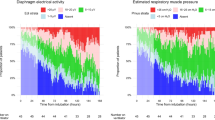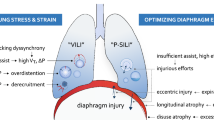Abstract
Background
Although β blockade (BB) in patients with chronic obstructive pulmonary disease (COPD) does not show signs of worsening pulmonary function or respiratory symptoms, the effects on cardiopulmonary exercise testing (CPET) remain unclear. The aim of this study was to determine whether BB affects exercise capacity, gas exchange, and hemodynamic responses in patients with COPD.
Methods
Twenty-four COPD subjects on BB were matched to 24 COPD subjects without BB according to age, gender, body mass index, and severity of COPD. All subjects underwent resting pulmonary function and symptom-limited CPET.
Results
Comparing COPD patients with and without BB revealed that percent peak oxygen consumption and VE/VCO2 nadir were not significantly different (45 ± 16 vs. 51 ± 23 %, p = 0.30, and 35.1 ± 8.5 vs. 36.2 ± 11.6 %, p = 0.69). Systolic blood pressure and heart rate at peak exercise were significantly decreased in COPD patients with BB (168 ± 16 vs. 185 ± 20 mmHg, and 109 ± 16 vs. 122 ± 14 bpm, respectively, p < 0.05).
Conclusion
Exercise capacity and gas exchange remain unaffected in patients with COPD in the presence of BB, although heart rate and blood pressure are lower. These findings imply that BB does not adversely affect functional capacity in patients with COPD.

Similar content being viewed by others
References
Ross RM (2003) ATS/ACCP statement on cardiopulmonary exercise testing. Am J Respir Crit Care Med 167:1451
Kennedy HL, Rosenson RS (1995) Physician use of beta-adrenergic blocking therapy: a changing perspective. J Am Coll Cardiol 26:547–552
Viskin S, Barron HV (1996) Beta blockers prevent cardiac death following a myocardial infarction: so why are so many infarct survivors discharged without beta blockers? Am J Cardiol 78:821–822
Gottlieb SS, McCarter RJ, Vogel RA (1998) Effect of beta-blockade on mortality among high-risk and low-risk patients after myocardial infarction. New Engl J Med 339:489–497
Salpeter SR, Ormiston TM, Salpeter EE et al (2003) Cardioselective beta-blockers for chronic obstructive pulmonary disease: a meta-analysis. Respir Med 97:1094–1101
Andrus MR, Holloway KP, Clark DB (2004) Use of β-blockers in patients with COPD. Ann Pharmacother 38:142–145
Salpeter SR, Ormiston TM, Salpeter EE (2002) Cardioselective beta-blocker use in patients with COPD (Cochrane Review). The Cochrane Library (update software), Oxford
Formgren H (1976) The effect of metoprolol and practolol on lung function and blood pressure in hypertensive asthmatics. Br J Clin Pharmacol 3:1007–1014
Quan S, Fenster P, Hanson C et al (1983) Suppression of atrial ectopy with intravenous metoprolol in chronic obstructive pulmonary disease patients. J Clin Pharmacol 123:341–347
Dorow P, Clauzel AM, Capone P et al (1986) A comparison of celiprolol and chlorthalidone in hypertensive patients with reversible bronchial obstruction. J Cardiovasc Pharmacol 8:S102–S104
Ades PA, Brammell HL, Greenberg JH et al (1984) Effect of beta blockade and intrinsic sympathomimetic activity on exercise performance. Am J Cardiol 54:1337–1341
Marsh RC, Hiatt WR, Brammell HL et al (1983) Attenuation of exercise conditioning by low dose beta-adrenergic receptor blockade. J Am Coll Cardiol 2:551–556
Wolfel EE, Hiatt WR, Brammell HL et al (1986) Effects of selective and nonselective beta-adrenergic blockade on mechanisms of exercise conditioning. Circulation 74:664–674
Gläser S, Koch B, Ittermann T et al (2010) Influence of age, sex, body size, smoking, and β blockade on key gas exchange exercise parameters in an adult population. Eur J Cardiovasc Prev Rehabil 17:469–476
Ades PA, Gunther PG, Meacham CP et al (1988) Hypertension, exercise, and beta-adrenergic blockade. Ann Intern Med 109:629–634
Maurer M, Katz SD, LaManca J et al (2003) Dissociation between exercise hemodynamics and exercise capacity in patients with chronic heart failure and marked increase in ejection fraction after treatment with beta-adrenergic receptor antagonists. Am J Cardiol 91:356–360
Witte KK, Thackray S, Nikitin NP et al (2005) The effects of long-term β-blockade on the ventilatory responses to exercise in chronic heart failure. Eur J Heart Fail 7:612–617
Wolfel E (2006) Exercise testing with concurrent beta-blocker usage: is it useful? What do we learn? Curr Heart Fail Rep 3:81–88
Wolk R, Johnson BD, Somers VK et al (2005) Effects of beta-blocker therapy on ventilatory responses to exercise in patients with heart failure. J Cardiac Fail 11:333–339
Celli BR, MacNee W, Agusti A et al (2004) Standards for the diagnosis and treatment of patients with COPD: a summary of the ATS/ERS position paper. Eur Respir J 23:932–946
Crapo R, Morris A, Gardner R (1981) Reference spirometric values using techniques and equipment that meet ATS recommendations. Am Rev Respir Dis 123:659–664
Crapo RO, Morris AH (1981) Standardized single breath normal values for carbon monoxide diffusing capacity. Am Rev Respir Dis 123:185–189
Crapo RO, Morris AH, Clayton PD et al (1982) Lung volumes in healthy nonsmoking adults. Bull Eur Physiopathol Respir 18:419–425
Naunheim KS, Wood DE, Mohsenifar Z et al (2006) Long-term follow-up of patients receiving lung-volume-reduction surgery versus medical therapy for severe emphysema by the National Emphysema Treatment Trial Research Group. Ann Thorac Surg 82:431–443
Tanaka H, Monahan KD, Seals DR (2001) Age-predicted maximal heart rate revisited. J Am Coll Cardiol 37:153–156
Spruit MA, Mercken EM, Wouters E (2007) Role of exercise testing in defining the response to interventions in chronic obstructive pulmonary disease patients. In: Ward SA, Palange P (eds) Latimer Trend & Co. Ltd, Plymouth, pp 208–220
Jones N, Makrides L, Hitchcock C et al (1985) Normal standards for an incremental progressive cycle ergometer test. Am Rev Respir Dis 131(5):700–708
Ferrazza AM, Martolini D, Valli G et al (2009) Cardiopulmonary exercise testing in the functional and prognostic evaluation of patients with pulmonary diseases. Respiration 77:3–17
Bartels MN, Gonzalez JA, Kim W, DeMeersman RA (2000) Oxygen supplementation and cardiac-autonomic modulation in chronic obstructive pulmonary disease. Chest 118:691–696
Bartels MN, Jelic S, Basner RC, Ngai P, DeMeersman R (2003) High frequency modulation of heart rate variability during exercise in patients with chronic obstructive pulmonary disease. Chest 124:863–869
Bartels MN, Jelic S, Basner RC, Ngai P, Gonzalez JM, De Meersman RE (2004) Supplemental oxygen increases arterial stiffness in chronic obstructive pulmonary disease. Respir Med 98:84–89
Bartels MN, Gates GJ, Downey JA, Armstrong HF, De Meersman RE (2012) Baroreceptor sensitivity after Valsalva maneuver in women with chronic obstructive pulmonary disease. Clin Auton Res 22(4):185–189
Packer M, Colucci WS, Sackner-Bernstein JD et al (1996) Double-blind, placebo-controlled study of the effects of carvedilol in patients with moderate to severe heart failure. Circulation 94:2793–2799
Colucci WS, Packer M, Bristow MR et al (1996) Carvedilol inhibits clinical progression in patients with mild symptoms of heart failure. Circulation 94:2800–2806
Cohn JN, Fowler MB, Bristow MR et al (1997) Safety and efficacy of carvedilol in severe heart failure. J Cardiac Fail 3:173–179
Buendía Fuentes F, Almenar Bonet L, Martínez-Dolz L et al (2009) Exercise tolerance after beta blockade in recent cardiac transplant recipients. Transpl Proc 41:2250–2252
Svedenhag J, Henriksson J, Juhlin-Dannfelt A (1984) Beta-adrenergic blockade and training in human subjects: effects on muscle metabolic capacity. Am J Physiol Endocrinol Metab 247:E305–E311
Savin WM, Gordon EP, Kaplan SM et al (1985) Exercise training during long-term beta-blockade treatment in healthy subjects. Am J Cardiol 55:D101–D109
Wilmore JH, Ewy GA, Freund BJ et al (1985) Cardiorespiratory alterations consequent to endurance exercise training during chronic beta-adrenergic blockade with atenolol and propranolol. Am J Cardiol 55:D142–D148
Hansen JE, Ulubay G, Chow BF et al (2007) Mixed-expired and end-tidal CO2 distinguish between ventilation and perfusion defects during exercise testing in patients with lung and heart diseases. Chest 132:977–983
Sue DY, Wasserman K, Moricca RB et al (1988) Metabolic acidosis during exercise in patients with chronic obstructive pulmonary disease. Use of the V-slope method for anaerobic threshold determination. Chest 94:931–938
Midorikawa J, Hida W, Taguchi O et al (1997) Lack of ventilatory threshold in patients with chronic obstructive pulmonary disease. Respiration 64:76–80
Belman MJ, Epstein LJ, Doornbos D et al (1992) Noninvasive determinations of the anaerobic threshold. Reliability and validity in patients with COPD. Chest 102:1028–1034
Acknowledgments
This work was supported by the VIDDA Foundation.
Conflict of interest
The authors have no conflict of interest to disclose.
Author information
Authors and Affiliations
Corresponding author
Rights and permissions
About this article
Cite this article
Thirapatarapong, W., Armstrong, H.F. & Bartels, M.N. Exercise Capacity and Ventilatory Response During Exercise in COPD Patients With and Without β Blockade. Lung 191, 531–536 (2013). https://doi.org/10.1007/s00408-013-9492-2
Received:
Accepted:
Published:
Issue Date:
DOI: https://doi.org/10.1007/s00408-013-9492-2




